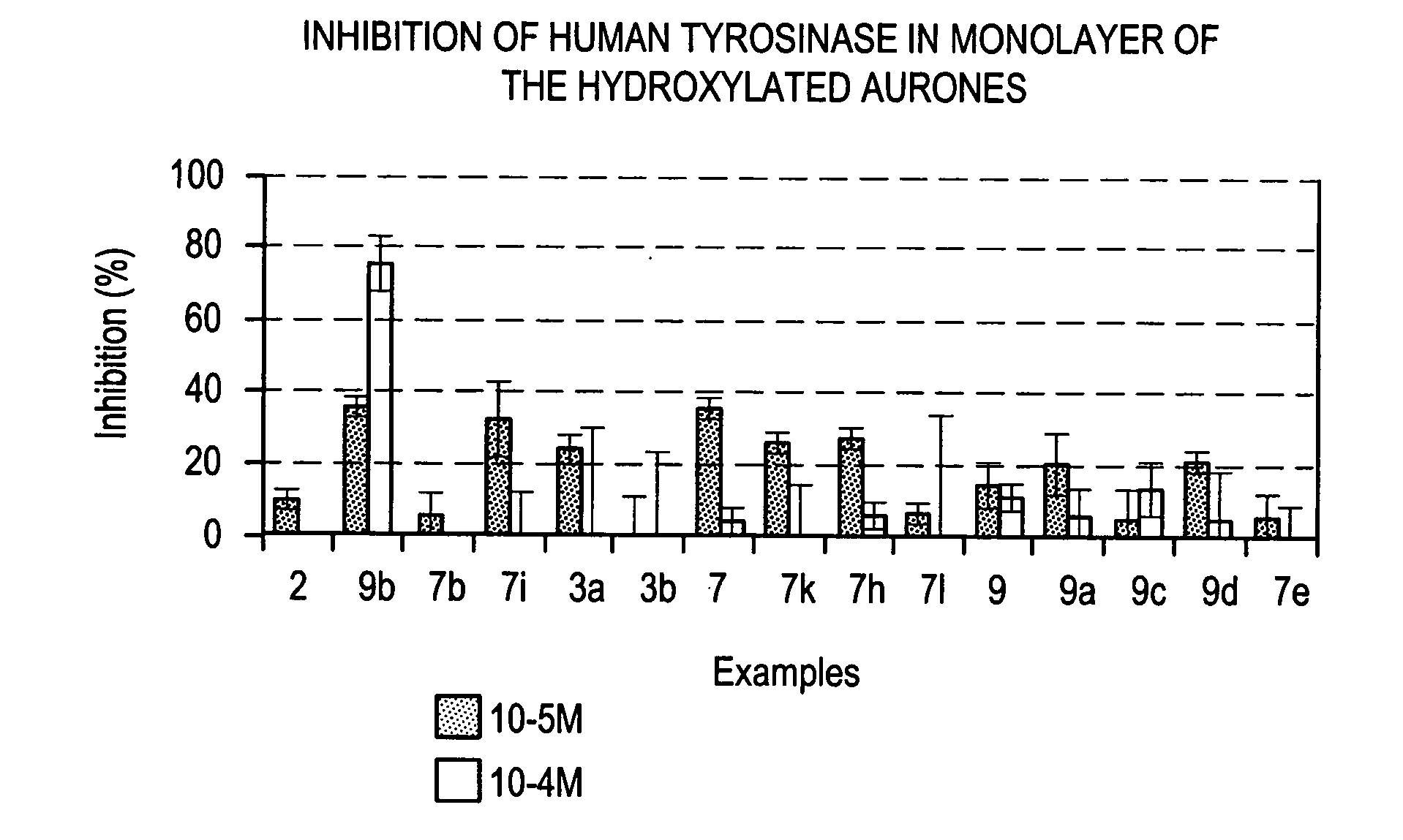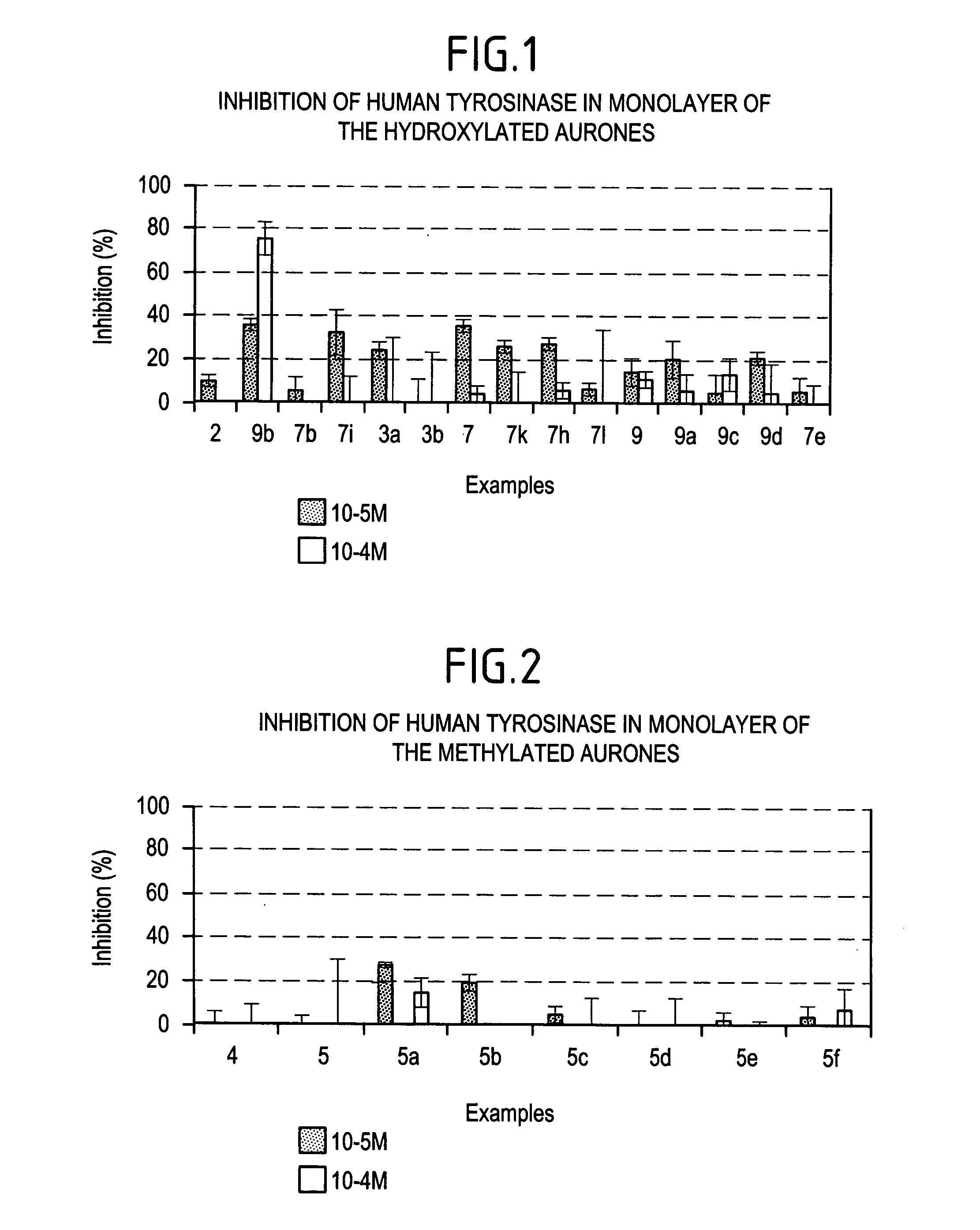Method of cosmetic depigmentation care by applying at least one aurone
a technology of aurone and skin care, applied in the field of cosmetic depigmentation, can solve the problems of irreversible damage to the genetic material of keratinocytes, extreme phototoxicity, and more toxicity, and achieve good melanogenesis-inhibiting activity and good depigmentation activity
- Summary
- Abstract
- Description
- Claims
- Application Information
AI Technical Summary
Benefits of technology
Problems solved by technology
Method used
Image
Examples
example 1
of the Invention
Synthesis of 2′, 4′, 6′-Trihydroxy-2-chloroacetophenone (R1=OH) and 2′,4′-Dihydroxy-2-chloroacetophenone (R1=H)
[0045]
[0046] To a solution of phloroglucinol (5 g, i.e. 39.6 mmol) or resorcinol (5 g, i.e. 45.4 mmol) in ether (150 mL), are added, successively, chloroacetonitrile (1eq) and zinc chloride (0.1eq). The whole is cooled to 0° C. and is allowed to react with gaseous hydrochloric acid for one hour. The precipitate formed is recovered by filtration and is washed with ether.
[0047] The precipitate is dissolved in 1N hydrochloric acid and the solution obtained is held under reflux for one hour. The medium is brought to ambient temperature and the orange precipitate formed is recovered and washed with water.
example 2
of the Invention
Synthesis of 4,6-Dihydroxybenzofuran-3(2H)-one (R1=OH) and 6-Hydroxybenzofuran-3(2H)-one (R1=H)
[0048]
[0049] The compounds obtained in Example 1, (R1=OH or H) are placed in suspension in methanol (100 mL). Sodium methoxide (2.5eq) is then added. The solution obtained is agitated for about 10 minutes in the cold and is then held under reflux for 1 h 30. After return to ambient temperature, the medium is acidified with a solution of HCl and is evaporated. The residue obtained is taken up into ethyl acetate. The organic phase is washed with water, a saturated sodium chloride solution, is dried over sodium sulfate and is evaporated to dryness, to give the expected product as an orange powder.
example 3
of the Invention
Synthesis of (Z)-2-Benzylidene-6-Hydroxybenzofuran-3(2H)-one
[0050]
[0051] To the compound obtained in Example 2 and wherein R1=H (1.0 mmol), in methanol, are added, successively, a 50% solution of potassium hydroxide (1.5 mL) and benzaldehyde (1.5 eq). The solution obtained is held under reflux for 1 hour. After return to ambient temperature, the methanol is evaporated off and the residue obtained is taken up into water. The solution obtained is acidified. A precipitate appears which is recovered by filtration and washed with water. The product is obtained as an amorphous powder after silica gel column chromatography.
[0052] The method described above can be applied by replacing the benzaldehyde:
by p-Ethylbenzaldehyde; in this case, the molecule of Example 3 is obtained with an ethyl group in 4′ and becomes Example 3a,
by 2-ethylbenzaldehyde; in this case, the molecule of Example 3 is obtained with an ethyl group in 2′ and becomes Example 3b,
by 4-hydroxylbenzald...
PUM
| Property | Measurement | Unit |
|---|---|---|
| Fraction | aaaaa | aaaaa |
| Fraction | aaaaa | aaaaa |
| Fraction | aaaaa | aaaaa |
Abstract
Description
Claims
Application Information
 Login to View More
Login to View More - R&D
- Intellectual Property
- Life Sciences
- Materials
- Tech Scout
- Unparalleled Data Quality
- Higher Quality Content
- 60% Fewer Hallucinations
Browse by: Latest US Patents, China's latest patents, Technical Efficacy Thesaurus, Application Domain, Technology Topic, Popular Technical Reports.
© 2025 PatSnap. All rights reserved.Legal|Privacy policy|Modern Slavery Act Transparency Statement|Sitemap|About US| Contact US: help@patsnap.com



